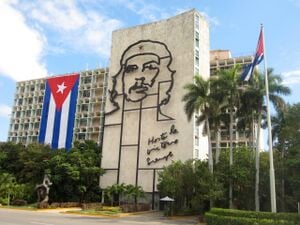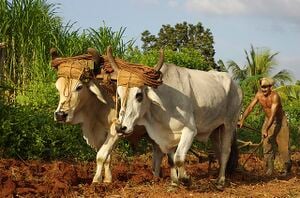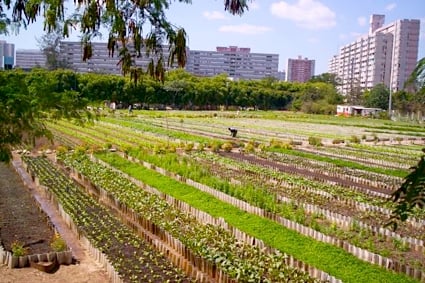Cuban Agricultural Cooperatives


Cuba's agrarian revolution originated in the mountains of the Sierra Maestra when Law No. 3 of the Rebel Army was formally proclaimed in October of 1958. The principle of the law: Land should be given to those who tilled it; with the goal of massive land distribution.
The first Agrarian Reform Law was enacted on May 17, 1959. The second Agrarian Reform Law was enacted in October of 1963. These laws made the agricultural systems of Cuba socialist. Agricultural production cooperatives began in 1975, and were enacted August 24, 1982, as a superior form of collective production of social property started after the farmers' decision to join their lands and other means of production.[1]
The first agrarian reform created cooperatives and then consolidating agricultural production in state farms. The second created the agricultural production cooperatives (CPAs) and the third was the 1993 law creating UBPCs. These abbreviations come from the Spanish names.[2]
Autonomy of Cooperatives[edit | edit source]

In 1993 the Cuban government gave approximately 45 percent of the country's farmland free of charge - in usufruct, the legal right of using and enjoying the fruits or profits of something belonging to another - to farmers willing to produce food cooperatively, called Basic Units of Cooperative Production (UBPCs). This critical change in land structure and labor relations fueled a massive conversion of farm-workers to farm-owners.[3]
The cooperative movement ceases to function when collective owners lack autonomy and management is restricted.
"It seems advisable that the state be less interventionist, that UBPCs enjoy broader and more transparent legal assurances, and that spaces to create their own more diversified organizational structures be opened. This would foster a public culture supporting cooperativism. The key is balance between the cooperatives' expectations and their potential. Thus, overbearing guidance would obstruct their consolidation and delay their economic and social self-assertion; yet, on the other side, excessive autonomy would lead to disorder and would undermine the principles of the cooperative movement.[4]
"Legislation authorizing the establishment of UBPCs from the former State farms in late 1993 marked the beginning of a significant process of transformation in the structure of agricultural production in Cuba. Nova González (1998) wrote: "the positive experience over more than 20 years with smaller Agricultural Production Cooperatives (Cooperativas de Producción Agropecuaria or CPAs) provided the foundation for the planning and creation of the UBPCs. Even during the early years of the Special Period, the CPAs had demonstrated their ability to better adapt to difficult economic conditions" (p.1)."[5]
Reformation[edit | edit source]
After two decades of existence the government is granting agricultural cooperatives formal independence expecting at least 327 or 75 percent to fail without recovery. New regulations provide Cuba's nearly 2,000 UBPC's more autonomy. But the government will stop subsidizing inefficient cooperatives as early as 2013, according to the government newspaper. At the end of 2010 about 300 of the 2,000 cooperatives declared a loss, and nearly 120 didn't present financial reports.[6]
Major challenges along this path remain for Cuba, as they have for other state-centered command economies as they entered a period of structural transformation.[7]
Current status[edit | edit source]
Cuba could likely build a cooperative-based sector in industry as well as agriculture. The vision of the nuevos lineamientos of the Cuban Communist Party is to increase the non-state employment to 35 percent of Cuban workers by 2015. This could lay the path for a cooperative based private sector. Cubans have a lot of experience with cooperatives but they are hierarchal instead of democratic which could hinder this process.
The Ministry of Agriculture announced it would support the creation of 2,600 new small urban and suburban farms, and the distribution of the use rights (in usufruct) to the majority of the estimated three million hectares of unused State lands.[8]
Performance Articulated by Different Sources[edit | edit source]

Pro-embargo[edit | edit source]
Cuba is currently importing somewhere between 60 and 80 percent of its foodstuffs, and must spend more than two billion U.S. dollars a year to pay for it.[9]
Pro-Cuba[edit | edit source]
The most important changes that led to the recovery of food sovereignty in Cuba occurred in the peasant sector. Controlling only 25 percent of the agricultural land In 2006, it produced over 65 percent of the country's food.[10]
Over the last 15 years Cuba has developed one of the most successful examples of urban agriculture in the world. With a population of over two million people, Havana has played dominant role in this type of agriculture.[11]
Authorities are seemingly focused on expanding self-employment or private enterprise as an alternative for the tens of thousands of people who have lost their jobs in cutbacks of public payroll. Additional advantages will be provided by legal regulations for the expansion of cooperatives not limited to agriculture.
"[These changes] would allow like-minded people to come together to carry out activities like those engaged in by self-employed workers, but with higher levels of productivity and without having to recur to a concentration of wealth or exploitative work relations," said Camila Piñeiro, a researcher with the Center for the Study of the Cuban Economy.[12]
References[edit | edit source]
- ↑ https://edis.ifas.ufl.edu/fe481
- ↑ http://web.archive.org/web/20180104025459/http://sdonline.org:80/29/cubas-agriculture-after-the-new-reforms-between-stagnation-and-sustainable-development/
- ↑ http://www.foodfirst.org/en/node/3071#_edn1
- ↑ http://web.archive.org/web/20180104025459/http://sdonline.org:80/29/cubas-agriculture-after-the-new-reforms-between-stagnation-and-sustainable-development/
- ↑ https://edis.ifas.ufl.edu/fe159
- ↑ http://www.cubastandard.com/2012/09/12/new-regulations-allow-more-autonomy-failure-of-co-ops/
- ↑ http://www.globalresearch.ca/cuba-s-coming-co-operative-economy/31966
- ↑ http://www.globalresearch.ca/the-achievements-of-cubas-ecological-agriculture/5316868
- ↑ http://www.havanatimes.org/?p=86589
- ↑ Raisa Pagés, "Necesarios cambios en relaciones con el sector cooperativo-campesino," Granma, December 18, 2006, 3.
- ↑ http://monthlyreview.org/2009/01/01/the-urban-agriculture-of-havana
- ↑ http://www.havanatimes.org/?p=55587